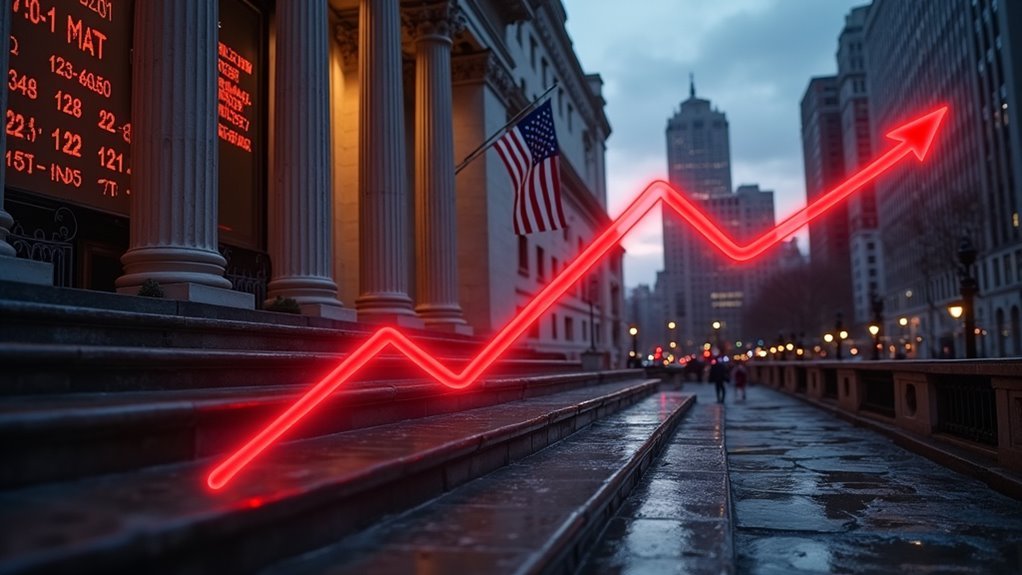Market trend analysis isn’t rocket science, but it’s no walk in the park either. Traders use technical charts, moving averages, and volume data to spot price patterns. Social media buzz and Google Trends reveal real-world sentiment. Supply and demand drive everything, while support and resistance levels mark key battlegrounds. Market noise makes things tricky – patterns can fool even seasoned pros. The deeper one looks beneath the surface, the clearer the trends become.

How does anyone make sense of today’s chaotic markets? It’s actually not rocket science – just a matter of recognizing patterns in the endless stream of data bombarding us daily. Market trends, those persistent directional movements that shape industries and economies, tell stories if you know how to read them.
Let’s get real: trends come in different flavors. You’ve got your classic uptrends – everyone’s favorite, where prices keep climbing like they’re trying to reach the moon. Then there’s the depressing downtrends, where everything seems to be on a perpetual slide. And don’t forget those annoying sideways trends, where prices just bounce around like a ping pong ball going nowhere. Social media monitoring provides real-time insights into these market movements. A successful analysis requires examining multiple time horizons to understand the complete market picture.
Smart trend spotters don’t rely on gut feelings. They use actual tools – technical analysis charts, Google Trends data, social media chatter, and boring but vital economic indicators. It’s like being a detective, but instead of solving crimes, you’re piecing together market mysteries. Understanding supply and demand dynamics is crucial as they fundamentally drive price movements in any market.
The real work happens in the trenches of data analysis. Moving averages smooth out the noise. RSI tells you when markets are getting too hot or cold. Volume changes confirm whether a trend is legitimate or just blowing smoke. Support and resistance levels act like invisible force fields that prices keep bouncing off.
Of course, it’s not all sunshine and rainbows. Trend spotting comes with its share of headaches. Sometimes what looks like a trend is just market noise – the equivalent of mistaking static for a radio signal. Cognitive biases mess with your head. Markets change faster than fashion trends. And just when you think you’ve figured it all out, the market throws a curveball.
But here’s the kicker: businesses that master trend analysis tend to survive and thrive. They develop products people actually want, target growing markets instead of dying ones, and position themselves ahead of industry shifts.
In today’s market jungle, trend analysis isn’t just nice to have – it’s crucial for survival.
Frequently Asked Questions
How Long Should I Hold Positions When Trading With Market Trends?
Position holding periods depend entirely on the trader’s chosen strategy and market conditions.
Position traders might ride trends for months or years, while swing traders typically hold for days to weeks.
Day traders? In and out within hours.
No one-size-fits-all here. Market volatility, asset type, and trading style dictate the timeline.
The trend’s strength and momentum matter more than arbitrary time frames.
What Role Do Trading Volumes Play in Confirming Market Trends?
Trading volume packs a serious punch in trend validation. It’s the ultimate reality check – high volume means traders are putting real money behind the move.
Low volume? That trend might be shakier than a house of cards.
Volume spikes often signal major price shifts coming, while steadily rising volume confirms trend direction.
When volume and price move together, that’s the sweet spot. When they diverge, something’s probably about to snap.
Can Market Trends Be Predicted Using Historical Price Patterns Alone?
Historical price patterns alone can’t reliably predict market trends.
Sure, technical analysis offers insight through chart patterns and indicators, but it’s an incomplete picture. Markets are complex beasts, influenced by countless external factors – economic data, global events, company fundamentals.
Even the most pristine chart pattern can collapse when reality intervenes.
Past performance, as they say, doesn’t guarantee future results. Period.
Which Technical Indicators Work Best for Identifying Trend Reversals?
Several technical indicators excel at spotting trend reversals. RSI readings above 70 or below 30 signal potential reversals.
Head and shoulders patterns pack a punch – they’re classic reversal signals. Volume spikes paired with price action can confirm the deal.
MACD crossovers often catch major turns. But here’s the kicker: no single indicator works perfectly.
Smart traders use multiple signals for confirmation.
How Do Economic Events Affect Established Market Trends?
Economic events can absolutely demolish established market trends.
GDP shockers? They’ll snap a trend faster than you can say “recession.”
Central bank surprises are real trend-killers – one surprise rate hike and boom, months of momentum vanish.
Major geopolitical crises create pure chaos, sending markets into tailspins.
Even positive news can derail downtrends instantly.
Markets hate surprises, period.
Economic bombshells don’t care about your technical analysis.








